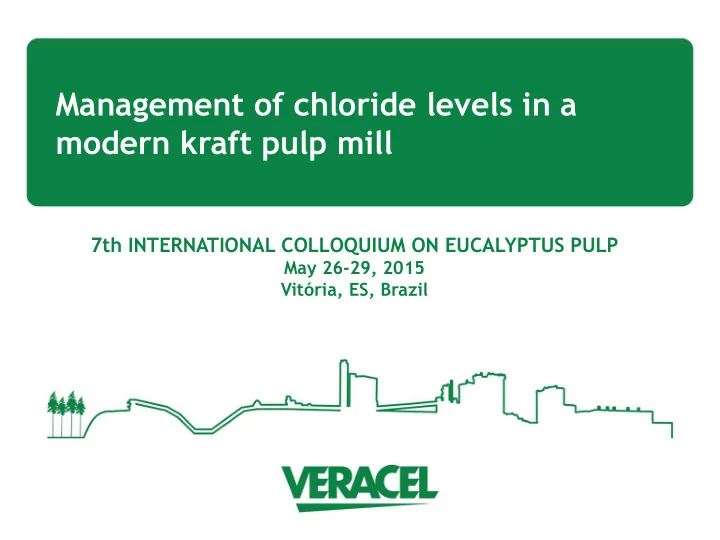

Management of chloride levels in a modern kraft pulp mill 7th INTERNATIONAL COLLOQUIUM ON EUCALYPTUS PULP May 26-29, 2015 Vitória, ES, Brazil
Introduction 50% 50% Veracel is a joint venture of Stora Enso and Fibria. Located in southern Bahia Annual production: 1.1 million tons of pulp
Introduction Project: Chloride reduction at Recovery Boiler ash Area: Recovery Boiler Objective: Reduce the Cl level in the RB ash and keep it below 3 % (guarantee to operate 12 months continuously).
Introduction Cl and K: Non process elements. Where they come from? Veracel, 2011 Where they come out? 84% Ash Leaching
Introduction Problems regarding Cl/K: Plugging: A sh melting points (first melting point and sticky temperature) Corrosion Reference: Hong Tran, 2007
Introduction Ash treatment technologies: Crystallization Ion exchange Ash Leaching ASH LEACHING - VERACEL Cl/ Cl/K Na Na 2 SO SO 4
Materials and Methods Study case in Veracel mill (2013/2014) The recovery boiler and the ash leaching are from Valmet. The boiler capacity is 4900 tds/day and the regular load of the ash leaching is 160 t/day .
Materials and Methods Tools used in the study: Data from Aspen (PIMS) Six Sigma Minitab WinGEMS Time Series Plot of Cloreto (%) 5,5 5,0 4,5 Cloreto (%) 4,0 3,5 3,0 3 2,5 2,0 3/1/11 30/6/11 21/11/11 9/5/12 9/10/12 12/3/13 6/8/13 10/12/13 21/5/14 6/10/14
Results and Discussion Chloride levels tendency (2011 – 2013) in the ash precipitator:
Results and Discussion The First step in this project was to increase the system availability. Actions: Study of shutdowns root causes Preventive maintenance each 15 days Training program with all operators and mechanics.
Results and Discussion Even with a good availability the chloride level was nevertheless over 3% most of the time. The main actions on this second phase of the project were: Purge control Implementation of new feedback and feedforward level control in ash leaching tank. Implementation of new torque control. Simulations of the effect of process changes upon the chloride levels in the mill.
Results and Discussion Purge control Increase the purge of ash leaching reject (liquid phase) until the chloride level of the dust reached below 3%. This occurred just after the shutdown, when the Cl was around 4.5%. PURGE
Results and Discussion Purge control: results during 15 days
Results and Discussion Automation improvements: a new feedback and feedforward level control was implemented in the ash leaching tank and a new torque control was created .
Results and Discussion Automation improvements: Torque plot of the ash leaching centrifuge before and after implementing a new torque control
Results and Discussion Once the ash leaching was running quite well and the chloride level was under control, the next actions were related to strategy during system stops. Simulations were made using a WinGEMs model of the mill in order to support the decisions related to the centrifuge shutdowns in a predictive way.
Results and Discussion An ash leaching stop of 20 days was simulated. The Cl content in ash increased from 3 to 5.4 weight %. The increase in the model and mill was generally the same. Time Series Plot of Cl and K (WinGEMS x Aspen) 6 Variable Cl (WinGEMS) K (WinGEMS) K (Mill) 5 Cl (Mill) Cl, K (%) 4 3 2 0,000 2,958 5,958 8,958 11,958 14,958 17,958 20,958 23,958 26,958 29,958 Time (days)
Results and Discussion A stop for 12 hours will increase the Cl content from 2.8 % to above 3 %. A total stop for more than 12 hours might require ash purge to prevent the risk of plugging. To keep the Cl levels lower than 3 % during a longer shutdown, the mill must purge around 45 kg ash/ADT to prevent it to rise
Results and Discussion The result after all those actions have contributed the decrease of the chloride level and keep this parameter under control, i.e. less than 3%. I Chart of Chloride (%) by Step Before Step 1 Step 2 5,5 5,0 4,5 4,0 % 3,5 UCL=3,103 _ 3,0 X=2,839 LCL=2,575 2,5 2,0 8/2/13 7/5/13 18/7/13 20/9/13 25/11/13 10/2/14 8/5/14 21/7/14 26/9/14 4/12/14 3/3/15
Results and Discussion The chloride level average has been around 2.84%. Interval Plot of Chloride (%) 95% CI for the Mean 4,5 4,19 4,0 Chloride (%) 3,5 3,25 3,0 2,84 Before Step 1 Step 2
Results and Discussion The results out of specification were reduced by 88% . 85.4% Out of Specification 10.3 % Out of Specification
Conclusions A preventive maintenance and training program with all operators were very important to run the system with a high availability. The purge control and the automation improvements allowed the decreased of chloride. Simulations were also important to predict the Cl and K levels to support strategies to keep the Cl in the ash under 3%.
Thank you! Work group: Carla Medeiros – Veracel Diego Monteiro – Veracel Flavia Silva – Veracel Kleverson Figueredo – Andritz Matheus Guimaraes – Fibria Per Andersson – Stora Enso Rickard Wadsborn – Stora Enso
Recommend
More recommend